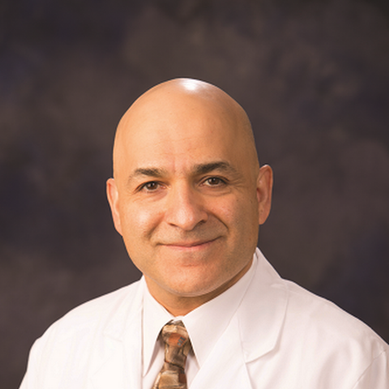Intricate Surgery for Rare Vascular Brain Tumor

“He was sitting and not speaking; just staring out into space,” Pat recalls. “When he walked, he shuffled his feet. He wasn’t acting like my husband and our friends started noticing too.”
They initially consulted with a cardiologist and chiropractor. After ruling out heart and bone/joint-related issues, the Ellingtons met with George Wilson, MD, a family medicine specialist in Rancho Mirage (recently retired after 60 years in practice). When an MRI revealed a brain tumor, Dr. Wilson immediately referred the Ellingtons to Board Certified Neurosurgeon Farhad Limonadi, MD. Dr. Wilson also reached out to Dr. Limonadi directly, asking him to see his patient.
“Mr. Ellington initially presented with dizziness and headaches, which many physicians might simply attribute to issues associated with aging,” Dr Limonadi says. “But Dr. Wilson suspected a disease related to the central nervous system or, more specifically, the brain.”
The diagnosis: a hemangioblastoma, a large vascular tumor in the right cerebellar hemisphere of the brain. Noncancerous, slow growing brain tumors, hemangioblastomas arise from the abnormal growth of cells that form blood vessels. Considered a Type 2 hemangioblastoma, which occurs in 60 percent of cases, Don’s tumor occupied over half of the right cerebellum.
“Dr. Limonadi came and told me, my daughter and son that Don had a brain tumor and we needed to have it removed as soon as possible, but he said ‘I will not do it until I have my A-plus team’,” Pat recalls.
“Mr. Ellington had what’s called obstructive hydrocephalus, meaning that the free passage of cerebrospinal fluid was obstructed,” Dr. Limonadi explains. “This meant that the pressure in his head had increased and, as a result, his neurological function was compromised.”

On April 15, 2022, Dr. Limonadi, with dedicated surgical, anesthesia and intraoperative monitoring teams in place, performed a total resection of the complex right subocciptal vascular tumor. The highly complex surgery involved accessing the brain via a craniotomy, disrupting the vascular link to the brain tumor, then removing the 3.7 cm tumor with minimal blood loss.
“The operation went well, and Don’s neurological status improved,” Dr. Limonadi notes. “We monitored him closely in the ICU to prevent any potential postoperative complications that may occur with brain surgery.”
“I remember waking up. It was nighttime and I had no idea where I was until I started speaking with my nurse,” Don says. “But I do remember that the hospital food was great,” he quips.
Pat recalls walking into Don’s hospital room with her son Ty and daughter Tammy, unsure of what to expect when they saw him.
“Don looked up at us, looked at my son and said, ‘Well, hi bud, how are you?’ and we couldn’t stop crying because he was talking normally” Pat says.
Don was discharged from the hospital in a week, after which he spent another eight days in a medical rehabilitation program at Rehabilitation Hospital of Southern California in Rancho Mirage. Multiple MRI scans since have found no evidence of residual or recurrent tumors.
Although Don still has some issues with slurred speech and balance, present challenges are minimal compared to when he was first diagnosed. Ty now runs the family propane business in Anza and although Don sometimes assists with service calls, he and Pat are more focused on enjoying travel and each other.
“We’re trying to play as much as we can, as long as we can — that’s my motto,” Don says.
Last fall, he, his son and daughter-in-law took a two-week motorcycle trip through Colorado while Pat followed them by car.
Pat acknowledges that they’ve both learned a valuable lesson when it comes to advocating for their health.
“If your doctors say get something done ‘stat,’ don’t drag your feet,” she says. “Dr. Limonadi said that Don only had a matter of days to be treated, or he might not be with us today.”
Dr. Limonadi also emphasizes that hemangioblastomas can occur in other areas of the body; most commonly, the spinal cord. For some patients, this can be associated with von Hippel-Lindau (VHL) Syndrome, a hereditary multi-system disorder that can present with multiple tumors in different parts of the body.
While the Ellingtons praise Dr. Limonadi for his skill and compassion, for his part, he encourages all primary care physicians to be fully engaged with their patients, and like Dr. Wilson, use their clinical knowledge and emphasis on detail to improve the course of each patient’s journey.
For more information or to contact Eisenhower Neuroscience Institute, call 760.837.8020, or visit EisenhowerHealth.org/Neuro.



